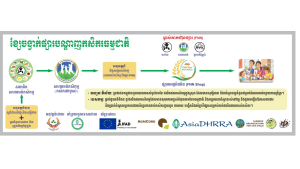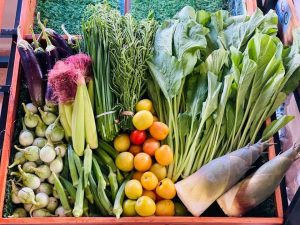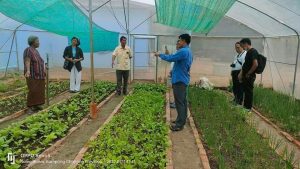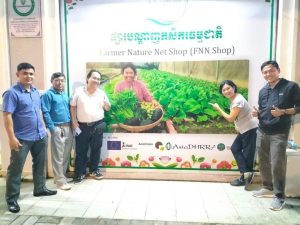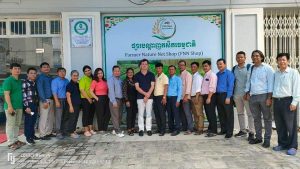Farmers’ Organization for Asia (FO4A) is a capacity-building program aiming to increase income and improve livelihood, food and nutrition security, and safety of family farming through greater integration of family farms in key agricultural value chains. In Cambodia, the project implements by Farmer Nature Net Association (FNN), supports by CamboDHRRA/AsiaDHRRA in cooperation with AgriCord and funding from IFAD and EU.
Under framework of FO4A, CamboDHRRA provides ongoing technical assistance to FNN and its members (agricultural cooperative) to establish AgriCoop distribution center. The center supplies various products produced by agricultural cooperative like vegetables, native chicken and pork, fruits, organic rice, and some processed products like cashew nuts, banana chips, etc.
AgriCoop distribution center plays important roles such as to streamline the supply chain, respond quickly to market demands, manage inventory efficiently, increase market reach, maintain product quality, save costs, and provide valuable data for decision-making. Followings are heighted the roles of AgriCoop distribution center for agricultural cooperatives and their members:
1. Efficient supply chain management: The center helps agricultural cooperatives streamline their supply chain, ensuring timely and efficient delivery of products to customers. These centers act as a centralized location for receiving, storing, and distributing products, and improving logistics.
2. Increased market reach: The center allows agricultural cooperatives to expand their market reach by acting as hubs for product distribution, cooperatives can deliver their products to a wider customer base and access new market segments more effectively.
3. Quick market response: The center enables agricultural cooperatives to respond quickly to market demands and fluctuations. By having products readily available in the distribution center, agricultural cooperatives can fulfill customer orders promptly, reducing lead times and improving customer satisfaction.
4. Optimal inventory management: The center provides agricultural cooperatives with a centralized location to manage their inventory effectively. Agricultural cooperatives can track stock levels, monitor product rotation, and implement inventory control measures to avoid overstocking or shortages. This ensures efficient use of resources and minimizes the risk of product wastage.
5. Quality control and assurance: The center plays a crucial role in maintaining product quality and freshness. By having proper storage facilities and implementing quality control measures, agricultural cooperative can ensure that their products reach customers in optimal condition, preserving taste, nutritional value, and overall product quality.
6. Cost savings: The center helps agricultural cooperatives save costs throughout the supply chain. Consolidating products in a centrally located distribution center reduces transportation costs, allows for bulk purchasing, and enables cooperatives to negotiate better deals with transportation providers. These cost savings can be passed on to customers, making agricultural cooperatives more competitive in the market.
7. Data analysis and decision-making: The center collect valuable data on product demand, sales patterns, and customer preferences. By analyzing this data, agricultural cooperatives can gain insights into market trends, make informed decisions about production planning and marketing strategies, and improve overall business performance.

 Cambodhrra Cambodian Partnership for Development Human Resource in Rural Area Association
Cambodhrra Cambodian Partnership for Development Human Resource in Rural Area Association
